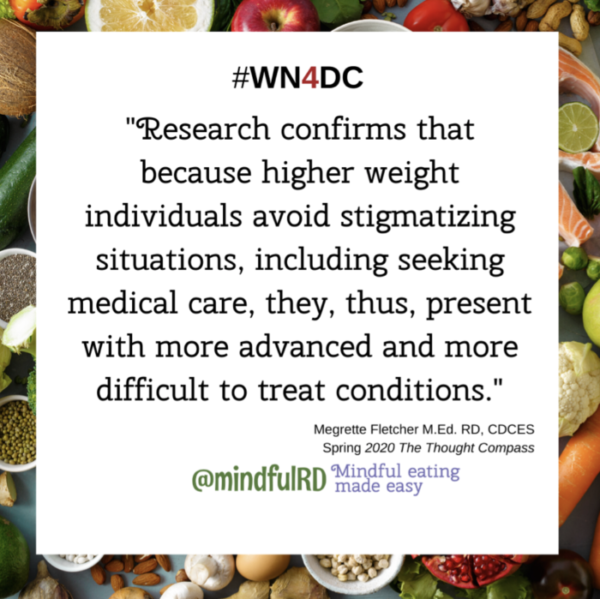If you are like many professionals you might not have considered the long-term impact of a weight stigma or a weight centered approach to diabetes and how this might impact diabetes care.

Research shows that the long‐term result is avoidance and postponement of care, which has a significant impact on health outcomes. Research confirms that because higher weight individuals avoid stigmatizing situations, including seeking medical care, they, thus, present with more advanced and more difficult to treat conditions. In fact, individuals who experience more obesity stigma report less health utility or they place a lower value on health. This is a suspected cause of the low utilization of DSMES services, which are less than 10% for insured clients.
Why Do They Continue to Avoid Care?
“Why don’t they [the patient] come in, don’t they know they have diabetes?” This is a question I have heard many times. While it seems benign, there is an invisible bias that may elude many medical professionals. To unpack this, let’s begin with the assumed value of medical care and health.
It makes sense that healthcare professionals value wellness and clients receiving medical care. This is what we do! Yet, our values may not be our client’s values. Assuming this is a shared experience and we share values is often why appointments fail to create behavioral change.
During a coaching session with Susan Dopart, RD, MI Instructor, she explained, “Research shows our ability to remain neutral and free of judgment pulls clients towards change.” This means that our values get in the way of our clients changing. Why? Our clients may value other things such as work, caring for family, or self-reliance just to name a few. While receiving medical care appears to be beneficial, for many higher-weight individuals who have internalized weight stigma, weight centered medical care is a harming, not a helping, experience. Being told over and over again to lose weight or that being fat is bad reinforces the narrative that a problem is their fault.
Let’s unpack two counseling examples, “You have diabetes. Your weight is a risk factor.” For someone who has experienced weight stigma and is sensitive to weight-related comments, stating that weight is a risk factor is likely to feel like blame to the client. Emotions can run high and interpret this comment to mean, “You have diabetes. Because of your weight, you now have diabetes. You caused the diabetes.” Here is another example, “You have diabetes. You should lose 10% of your body weight to improve your blood sugar.” Again, this might be interpreted as “You caused this problem and now you HAVE to go on that XYZ diet [a suggestion that carries its own pain and past experience] and never eat foods you enjoy or you will never be healthy.”
Many providers have confessed confusion, frustration, and resentment that clients can’t hear them. “What am I supposed to say? I am giving them the facts, which I get isn’t fun, but I don’t have another choice.”
How to Talk to Patients
Counseling clients is imperfect. It is both an art and a science. Approaches, such as Motivational Interviewing (MI), suggest that the emphasis should shift from offering solutions to listening to the client. For example, shifting the initial statement, “You have diabetes. Your weight is a risk factor.” to “You have diabetes.” [Silence] “What thoughts are you willing to share with me?” or “What are you thinking?”
Here is another example of how to rephase the previous example, which was, “You have diabetes. You should lose 10% of your body weight to improve your blood sugar,” to become, “You have diabetes. What ideas do you want to explore to improve this condition / your blood sugar?”
The invitation to the client to engage in care begins by asking the client to provide ideas and suggestions. These conversations are disarming because they are not providing solutions but more importantly, they are engaging the client in the process of finding a solution.

